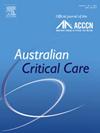在重症监护病房为患者及其家属提供文化适宜且尊重患者的临终关怀:混合方法研究
IF 2.7
3区 医学
Q2 CRITICAL CARE MEDICINE
引用次数: 0
摘要
澳大利亚的文化和语言都很多样化。然而,人们对根据不同文化需求和偏好提供临终关怀的障碍知之甚少。目的本研究的目的是测量重症护理护士在提供临终关怀方面的文化智力、舒适度和能力,并探讨为不同文化背景的患者及其家属提供临终关怀的感知障碍。方法采用调查和访谈相结合的解释性混合方法。2024年2月发布了一项全国性调查,收集了重症护理护士在提供临终关怀时的能力、舒适度和文化智力的数据。在2024年3月至4月期间对护士进行了个别访谈。定量数据采用描述性和推理性统计进行分析,开放式调查和访谈结果采用归纳内容分析进行分析。从89份调查回复的样本中,护士在重症监护室工作的年数中位数为15年(四分位数间距= 7.0-21.5)。受访者来自14个不同的国家,20.2% (n = 18)说第二语言,50.6% (n = 45)有宗教信仰。三分之一完成了临终关怀培训(34.8%,n = 31),而31.5% (n = 28)完成了文化多样性培训。接受过临终关怀培训的被调查者对临终关怀提供的舒适和能力得分(Mdn = 91.0)显著高于未接受过培训的被调查者(Mdn = 80.5, U = 1301.0, p <;0.001)。受访者承认对多样性有一些不适应,以及优先考虑舒适和尊严、理解和解释文化偏好的重要性。还确定了与专业口译人员接触有关的沟通挑战。结论危重病护理护士对临终关怀的舒适度和能力以及对障碍的认知是了解的关键,因为临终关怀不仅仅是临床护理。必须支持护士通过提供符合文化和宗教需求和偏好的护理来建立理解和舒适,并优化获得专业口译员的机会。本文章由计算机程序翻译,如有差异,请以英文原文为准。
Culturally appropriate and respectful end-of-life care for patients and their families in the intensive care unit: A mixed-method study
Background
Australia is culturally and linguistically diverse. Yet little is known about perceived barriers to the provision of end-of-life care tailored to diverse cultural needs and preferences.
Aims
The aim of this study was to measure critical care nurses’ cultural intelligence, comfort, and capabilities in providing end-of-life care and explore the perceived barriers to providing end-of-life care for culturally diverse patients and their families.
Method
An explanatory mixed-method approach was undertaken utilising surveys and interviews. A national survey was distributed in February 2024, collecting data about critical care nurses’ capability, comfort, and cultural intelligence when providing end-of-life care. Individual interviews were conducted with nurses between March and April 2024. Quantitative data were analysed using descriptive and inferential statistics, and open-ended survey and interview responses were analysed using inductive content analysis.
Findings
From the sample of 89 survey responses, the median number of years nurses worked in the intensive care unit was 15 (interquartile range = 7.0–21.5). Respondents came from 14 different countries, 20.2% (n = 18) spoke a second language, and 50.6% (n = 45) were affiliated with a religion. One-third had completed end-of-life care training (34.8%, n = 31), whilst 31.5% (n = 28) had completed training in cultural diversity. Respondents who completed end-of-life care training had significantly higher comfort and capability scores regarding end-of-life care provision (Mdn = 91.0) than those with no training (Mdn = 80.5, U = 1301.0, p < 0.001). Interview participants acknowledged some discomfort with diversity, and the importance of prioritising comfort and dignity, and understanding and interpreting cultural preferences. Communication challenges associated with professional interpreter access were also identified.
Conclusion
Critical care nurses’ comfort and capabilities with end-of-life care and perceptions of the barriers are critical to understand because end-of-life care is about more than clinical care. Supporting nurses to build their understanding and comfort with providing care that aligns with cultural and religious needs and preferences, and optimising access to professional interpreters, is imperative.
求助全文
通过发布文献求助,成功后即可免费获取论文全文。
去求助
来源期刊

Australian Critical Care
NURSING-NURSING
CiteScore
4.90
自引率
9.10%
发文量
148
审稿时长
>12 weeks
期刊介绍:
Australian Critical Care is the official journal of the Australian College of Critical Care Nurses (ACCCN). It is a bi-monthly peer-reviewed journal, providing clinically relevant research, reviews and articles of interest to the critical care community. Australian Critical Care publishes peer-reviewed scholarly papers that report research findings, research-based reviews, discussion papers and commentaries which are of interest to an international readership of critical care practitioners, educators, administrators and researchers. Interprofessional articles are welcomed.
 求助内容:
求助内容: 应助结果提醒方式:
应助结果提醒方式:


